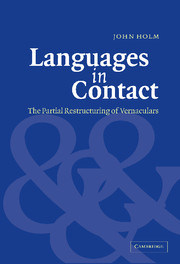6 - Conclusions
Published online by Cambridge University Press: 22 September 2009
Summary
Introduction
This concluding chapter will attempt to relate the social information in chapter 2 to the linguistic information in chapters 3–5 in order to provide a basis for a theory that can account for the facts known about the five languages examined here: what led to their partial restructuring and how this process affected their structure.
Social factors in partial restructuring
Chapters 2 pointed to a single, overriding social factor in the development of African American English, Afrikaans, Brazilian Vernacular Portuguese, Nonstandard Caribbean Spanish, and the Vernacular Lects of Réunion French as varieties distinct from both unrestructured overseas varieties of their source languages (e.g. the English of Ontario, the extinct Dutch of New York and New Jersey, the Portuguese of Madeira, the Spanish of Chile, or the French of Quebec) and completely restructured creole languages (e.g. Guyanese Creole English, the extinct Creole Dutch of the Virgin Islands, Guiné-Bissau Creole Portuguese, Palenquero Creole Spanish, or Mauritian Creole French). That social factor is the demographic balance, during the first century of a new language's development, of native speakers versus non-native speakers of the European source language.
Parkvall (2000) is certainly correct in his conclusion that this demographic ratio is not the only social factor that determines the degree of language restructuring: there are other relevant factors, such as an incoming population already having some fluency in a common restructured language brought in from elsewhere, such as the English-Creole-speaking slaves imported into the southern American colonies during the seventeenth century (introduction to chapter 2 and section 2.1.1).
Information
- Type
- Chapter
- Information
- Languages in ContactThe Partial Restructuring of Vernaculars, pp. 135 - 146Publisher: Cambridge University PressPrint publication year: 2003
